Treatment guide
Hair Transplant Abroad: Cost, Surgery Overview, Results, Recovery Timeline

Аrticle author
Kateryna Trehub

Medically reviewed by
Fahad Mawlood
Updated: 22.09.2021
Minutes to read: 23 minutes
Fast Facts
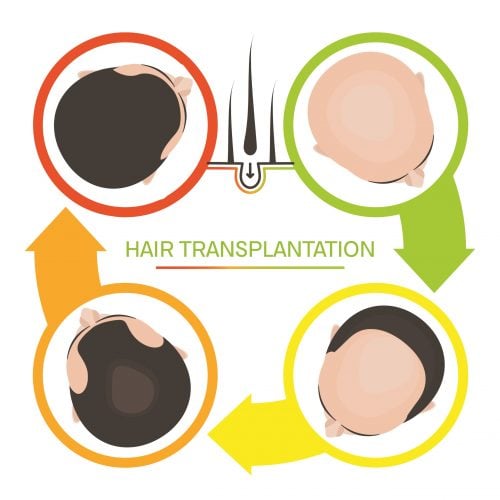
- how a hair transplant is processed
- who are the best candidates
- how much it costs in different countries
- where the best hair transplant clinics are located
- how to arrange your hair transplant journey abroad fast and safely.
Hair Transplant: Fast Facts
WHO IS A CANDIDATE
- Both men and women who have concerns about hair loss
- Age 25+ years old
- Individuals with realistic outcome expectations from hair transplant surgery
- Patients with a sufficient number of healthy hairs for growing on the donor areas (mostly, the nape)
- Men and women without severe diseases.
TREATMENT DURATION
- A procedure lasts 4-8 hours. Its duration depends on the intervention complexity and a number of grafts required for transplantation.
- A patient can leave a hospital just after the procedure.
RECOVERY DURATION
A person can resume working in 2-5 days after surgery. You will observe hair regrowth in 6-12 months.SUCCESS RATE
The success rate of a hair transplant ranges within 90-98%, determined by the patient’s health condition, quality of donor follicles, and doctor’s qualification.
POTENTIAL RISKS AND SIDE EFFECTS
- Scarring
- Infection
- Soreness, itching, and swelling of the scalp
- Bleeding
- Inflammation
- Crusts or pus cluster around the implanted grafts
- The scalp sensation loss.
How Much Does Hair Transplant Cost?
| Turkey | Mexico | Thailand | USA | |
|---|---|---|---|---|
FUE | from $950 | from $2,600 | from $3,600 | from $7,500 |
FUT | from $950 | from $2,500 | upon request | from $7,000 |
Organic | from $2,900 | upon request | upon request | upon request |
DHI | from $1,250 | upon request | upon request | upon request |
Afro | from $1,100 | upon request | upon request | upon request |
Female | from $1,300 | upon request | upon request | upon request |
Note that each clinic provides the cost for the different number of grafts. Some medical facilities, like Turkish ones, offer package prices for a procedure. It means that you will pay the same cost independently of how many grafts you need for a transplant.
Below you can find the approximate price, depending on the number of grafts:
| Turkey | Mexico | Thailand | USA | |
|---|---|---|---|---|
| 1,000 grafts cost | from $950 | from $1,700 | from $2,400 | from $5,000 |
| 3,000 grafts cost | from $950 | from $4,800 | from $6,900 | from $14,700 |
| 4,000 grafts cost | from $950 | from $6,000 | from $8,000 | from $19,200 |
| from $7,000 | from $950 | from $7,000 | from $9,500 | from $23,500 |
Hair Transplant Packages
Reasons for Hair Transplant
Cope with Androgenic Alopecia
In most of the cases, doctors prescribe hair transplants for men and women with androgenic alopecia (also referred to male pattern baldness). It is a condition when men experience balding and hair receding, while women — thinning hair. Hormonal or genetic reasons typically cause androgenic alopecia. When dihydrotestosterone (DHT), a hormone evolved from testosterone, ties up with testosterone, follicles can become weak and start falling out. Women also have testosterone, so when they experience testosterone and estrogen imbalance, androgenic alopecia may occur.
A person with male pattern baldness can count on great outcome after a hair transplant. A doctor takes follicular units for replacement from the donor zones functioning independently from hormonal influence and places them on hairless zones. So, a patient receives a long-lasting result without hair loss recurrence.

Improve hairline growth
Many men are not satisfied with how their natural hairline looks. Hair transplant effectively solves this issue, allowing to model a perfect hairline. After this procedure, a patient looks younger and more attractive.
Correct beard, eyebrows, or eyelids
A hair transplant is an effective way to improve your hair growth not on the head exceptionally. Women who dream about more expressive eyelids and eyebrows, and men who want to get bushy masculine beards, can opt for hair transplants.
Get back your self-confidence
Often, receding hairlines are not only about visual imperfection. It also becomes a psychological problem for many people. They can feel attractive, lose their confidence, and even fall into depression. So, a hair transplant can be the only solution to gain a person’s self-esteem in this case.
Who Is Not a Candidate for Hair Transplant?
Despite all benefits of hair transplant, there are occasions when this intervention can be ineffective or even contraindicated. Hair transplant surgery cannot be applied for people who have:
- Blood clotting disorders. In this case, even the smallest damage can cause bleeding.
- Diseases of the nervous system. So, a patient should discuss this occasion with a doctor before a procedure to avoid negative consequences.
- Diabetes. Even if a doctor gives allowance to perform a hair transplant, you should remember that the risk of such a complication as infection increases much in the case of diabetes.
- Skin diseases such as dermatitis, eczema, etc. It is necessary to treat these conditions or achieve their remission.
- Age under 25. Hair transplant may be ineffective for younger men because their hormones can fluctuate and bald patterns have not been determined yet.
Hair Transplant Types
Plastic surgery does not stand still. So nowadays, the leading clinics offer safe and helpful methods of hair transplant surgery that allow achieving the best outcome without causing many risks or complications. Below you can find the description of the most common hair restoration surgery types, compare their pros and cons, specifics of the performance.
FUT hair transplant
FUT (Follicular Unit Transplantation) is an option to transplant hair, when a surgeon cuts out a thin strip of skin together with hair from the nape. Then, a doctor removes follicles and implants them into areas with thinning or receding hairs. Typically, a scar remains on the donor’s side from where the strip has been taken. However, it will be hidden under the hair growing above, so nobody will even notice it.
Nowadays, FUT hair transplant is rarely used because of its high level of injury, increased risk of bleeding, and scarring. However, FUT is usually cheaper than FUE, takes less time to perform, so it allows transplanting more grafts per 1 procedure. Only several medical centers can offer to perform FUT.
FUE hair transplant
FUE (Follicular Unit Extraction) is one of the most sought-after hair transplant types among patients. A doctor extracts hair follicles from the donor area using a micropunch, a special instrument to delicately remove the follicles out of the skin without causing visible scars. A specialist forms grafts (a bunch of 2-4 follicles), places them in a special fluid to maintain their viability. At the same time, a doctor makes tiny incisions on the donor areas preparing the places for planting grafts. As a result, a hair transplant technician designs the desired hairline and its density without much bleeding and scarring.
FUE can also be an option as a female hair transplant. You can pick a clinic here to get this FUE type.
The leading hair transplant clinics focus on performing FUE surgery and its subtypes. Below you can find info about most popular modifications of FUE method:
DHI hair transplantation
DHI (Direct Hair Implantation) is a FUE modification, created by DHI Global Medical Group company. The difference is in the manner of follicles extraction — during FUE, a surgeon manually pulls out follicles and then implants them. During DHI, a doctor uses a special instrument that works like a fountain pen that simultaneously extracts and implants grafts. This automated approach allows transplanting a greater number of grafts per one operation.
ARTAS robotic hair transplant
Robotic hair transplant is an improved hair plantation type managed with the ARTAS robotic system under a surgeon’s control. This method offers a wide range of benefits for a patient:
- 3D planning of the future outcome prior to a procedure
- No pain and scarring
- The robot transplants 2,000 grafts per hour, so it is possible to perform procedures faster and implant more grafts per one procedure compared to traditional FUE.
- High accuracy of a procedure. The ARTAS robot analyzes the quality of follicles for replacement, so it selects only primary ones. Moreover, the robot can form a perfectly even hairline because it “does not get tired” and its movements remain accurate till the end of the procedure.
The cost of a robotic hair transplant can be 1.5-2 times higher than traditional FUE. However, it may be even profitable for patients who have advanced baldness: it is possible to transplant more grafts per one session by a robot. So, a patient will not waste money for tickets and a hotel to carry out one more operation in advance.
Stem cell hair transplant
This type of operation (also called organic hair transplant) is a combination of FUE transplantation with stem cell injections. Stem cells are specific types of our body that are able to produce any type of human cells. A surgeon infuses stem cells into the donor and the recipient areas. As a result, the recovery goes smoothly, no stitches are needed, the hair grows fast. This procedure is not widely spread, as far as FDA does not officially approve it. However, medical centers in several countries (Turkey, Ukraine, for instance) use stem cell injection to enhance hair transplant results.
There are also some specific hair transplant types as:
- Afro hair transplant is considered a traditional FUE performed for curly hairs. The procedure requires more advanced skills from a surgeon because implantation of curly hairs is more complicated than straight ones.
- Unshaven hair transplant represents the performance of FUE but without shaving hair. When a surgeon works with long hair, it requires more skills and accuracy to get a follicle undamaged. This method allows to build a perfect hair growth direction, but it significantly limits the number of planted grafts per session. See the prices of the procedure here.
Dr. Aziz Aksöz from Estetik International shares which hair transplant option is the best
Read the interview of Dr. Aziz Aksöz, who answers the most popular questions about hair replacement surgery
Hair Transplant
FUE
vs
FUT
- Surgical procedure
- 3 days of recovery
- Hardly visible scars may take place
- Mild post-op discomfort
- A higher chance to damage follicles during their extraction process
- Excellent outcome
- Surgical procedure
- 7-10 days of recovery
- Long and visible scar on the nape remains
- Moderate post-op discomfort
- A lower chance to damage follicles during their extraction process
- Excellent outcome

Hair Transplant Procedure Overview
How to Prepare for Hair Transplant Surgery?
You should go through these steps to get ready for a procedure:
Get the bill
Send photos of bald areas to your doctor to determine how many grafts you need and calculate the final cost. Some clinics may ask to make prepayments. So, make sure that you have picked a licensed medical facility you can trust.
Schedule the procedure
When you have selected a doctor to manage your hair transplant, schedule the date of the procedure. Think over when it is more convenient for you to take several days off and plan your trip.
Refuse smoking and alcohol
It is essential to stop smoking and drinking alcohol at least 72 hours prior to surgery. These habits can dilute the healing process and complicate your recovery.
Do not get a haircut
Avoid changing your hairdo before a procedure. Let the hairs on the donor area grow fully.
Make a massage of your scalp
A doctor may recommend massaging your scalp for at least 2 weeks before a hair transplant. This manipulation is supposed to make skin softer and enhance blood flow.
Stop taking some pills
It is usually recommended to stop taking blood-thinners such as aspirin and anti-inflammatory drugs before a procedure. Antidepressants, some herbs should also be limited or cancelled. Ask your doctor for detailed information.
What Should I Expect During the Procedure?
When you arrive at the clinic, you pass medical tests, and then a hair transplant starts. Usually, the surgery process consists of such steps:
A nurse or a doctor shaves the scalp before a procedure. If you plan an unshaven procedure, this step is omitted.
A doctor administers local anesthesia with a needle, so you will not meet discomfort during a procedure.
A surgeon gets follicular units from the donor area. The way how it is processed depends on the hair transplant type. Within FUT, a doctor makes a long incision on the patient’s nape and cuts out the strip of skin with hairs. Then, a surgeon divides this strip into follicles and forms grafts (a bunch of 3-4 follicles). In the case of FUE, a specialist pulls out the follicles by a punch one by one without injuring much of the donor area.
Grafts implantation
When the grafts have been formed, a doctor plants them into the recipient area (with bald zones, receding, or thinning hair). Before planting, a specialist cuts out tiny openings for placing grafts there. It is possible to transplant up to 4,500 grafts per 1 procedure.
Bandage covering
When a procedure is over, a doctor stitches the donor area in case of FUT hair transplant. Then, he/she puts a bandage to cover the scalp. A patient should wear it for 2-3 days. The whole procedure typically takes 4-8 hours.
Recovery
The timeline of hair growth and recovery looks the following way:
You can observe the first noticeable changes after hair transplant. However, it is still early to estimate the outcome.

Post-op Instructions
Tips from Bookimed Patients
Any tip must be approved by your surgeon.
The list mentioned-above of instructions for hair transplant recovery is general. However, each case is individual. And only a person who has already passed through the hair transplant recovery can tell more about the healing process and some unpredictable issues. Below you can find summarized advice given by Bookimed patients who have already overcome the recovery after intervention.
- Try to relax after the intervention completely. It is better to take about 2 weeks off, stay at home and go through the post-op recovery without stress.
- If necessary, take some sleeping pills for the first nights after surgery. You can feel a sleep disorder due to the unusual position recommended for sleeping. Your surgeon must prescribe those medications adequate for you.
- You can feel some pain on the 2nd day after surgery. It is not strong. However, you can take some painkillers to minimize discomfort.
- You can massage the scalp on the 3rd day after surgery to distribute the accumulated fluid and reduce swelling. Put your fingers in the middle of the forehead and slightly move them towards the samples.
- If you feel some lasting sensation and redness of the skin, use aloe vera gel.
- After having a shower in 7 days post-op, all the stabs come off.
- You send your photos to a clinic to check the progress in 2-3 weeks, then in 3, 6, and 12 months.
- Use SPF cream for 4-6 months after surgery.
Risks and Complications
Before and After Photos
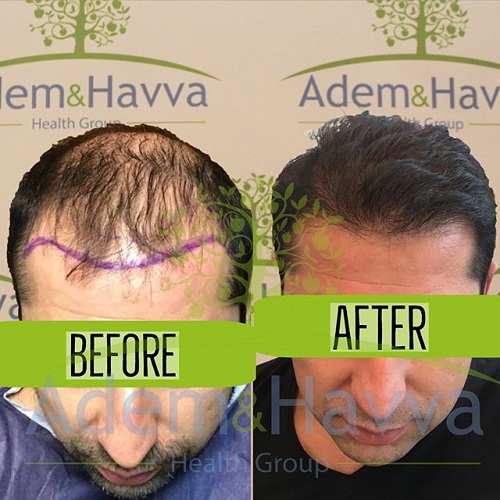
Procedure: Hair transplant
Hospital: Adem and Havva Medical Center
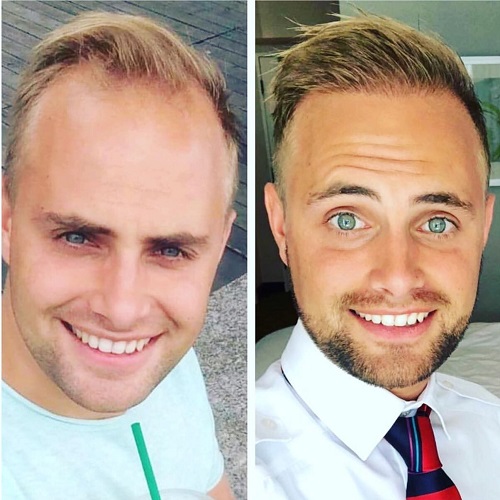
Procedure: Hair transplant
Hospital: Istanbul Aesthetic Plastic Surgery Center
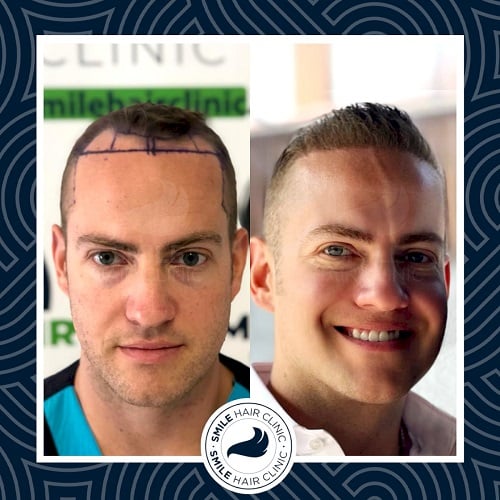
Procedure: Hair transplant
Hospital: Smile Hair Clinic
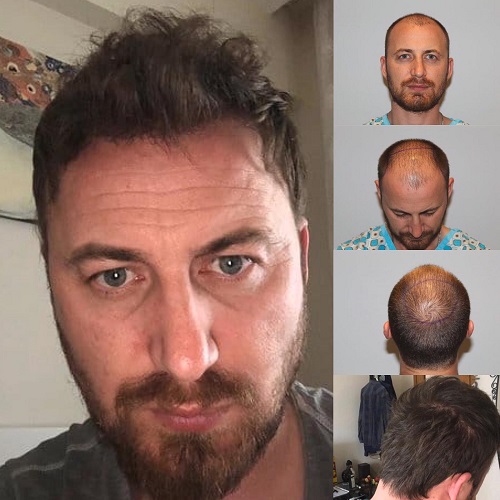
Procedure: Hair transplant
Hospital: Memorial Bahçelievler Hospital
Is Hair Transplant Worth It?
Hair transplant is an effective and often the only option to forget about receding hair and baldness. Patients usually tolerate a hair transplant well, provided a highly-skilled doctor manages the procedure. Million people across the world have experienced this surgery, and now enjoy their updated appearance. According to the Realself data, 94% of patients consider hair transplant as worth it to perform.
If you still ask yourself whether you should have a hair transplant, see the verified reviews about the procedure on the Bookimed.com website.
Where to Get Hair Transplant: Abroad or at Home?
If you plan to have a hair transplant, you should first decide where you want to get surgery: abroad or at home.
The main reasons why men and women prefer traveling overseas for plastic surgery instead of staying home are:
- 2-5 times cheaper price. A hair transplant is considered a cosmetic procedure, so health insurance will not cover the expenses. So, the pricing issue remains topical for many people. So, the best solution is to search for affordable options overseas. Such countries as Turkey and Mexico offer affordable hair transplant deals. At the same time, the quality of surgery is at a high level.
- Board-certified doctors. The doctor’s skills significantly influence the success of the intervention. But sometimes, it is difficult to find a highly-experienced surgeon in the country of residence. If you choose to have a hair transplant abroad, you receive access to the best hair surgeons.
- Advanced level of comfort. It is vital to relax after experiencing a hair transplant. Licensed and certified international medical centers do their best to make patients’ stay comfortable, satisfying their needs.
How to Arrange My Hair Transplant Journey Overseas?
If you are planning to get a hair transplant abroad, you should keep in mind such points to make your experience the best:
- Pick a country where you want to get a hair transplant. If you are looking for cheap options, you can consider Turkey or some European countries such as Poland, the Czech Republic. If you want to combine a procedure with holidays, Turkey, Mexico, and Thailand are also suitable variants for this purpose.
- When you have already selected a country for a hair transplant, your further step is to choose a clinic holding proper licenses and certificates to ensure your safety and high plastic surgeons’ qualification.
- When a plastic surgery center has been found abroad, you have checked patient reviews, before and after photos, doctor CVs, and you can schedule a hair transplant date overseas. You should guarantee your arrival by paying 10-20% of the total hair transplant deal to book a convenient date.
- When your hair transplant date is confirmed, you can start arranging your trip: book flight tickets and a hotel. These issues are paid additionally.
You can arrange hair transplants overseas yourself or entrust all travel issues to the Bookimed medical tourism platform.
When a person has never traveled abroad for medical assistance, it may be difficult to arrange the trip themselves. For this purpose, it is better to ask medical tourism agencies for assistance to make the trip safe and treatment successful. Bookimed, is No.1 medical tourism platform in the world, assists patients in treatment arrangements in the leading medical centers across the world. Bookimed team knows all specifics of healthcare in any country; we collaborate with international clinics where the leading hair transplant surgeons practice. With us, you can experience your hair transplant journey fast, safe, and at an affordable price. Submit a request on Bookimed, and we will:- find a proper option according to your budget
- pick the most appropriate country and clinic for your case
- provide with CVs of leading hair transplant surgeons
- schedule a procedure for a convenient date for you
- book flight tickets and partner hotels with discounts.
FAQs about Hair Transplant Surgery Abroad
Doctors and nurses of the hair transplant clinics that serve international patients usually speak English. The service of a language assistant who speaks your language is also available.
Usually, reputable cosmetic surgery centers provide their clients with a transfer. This option may be a part of a hair transplant package or is paid additionally.
The recovery after a hair transplant takes up to a week. It is recommended for a patient to stay in the country for at least 4 days.
Hair Transplant during COVID: Rules and Safety
During the COVID pandemic, medical facilities have made adjudgements to their functioning and serving of patients. International hair transplant centers focus on the patients’ safety. They apply all measurements for their clients’ protection and stop the spread of the virus: provide social distance, renovate ventilation systems, and permanently conduct disinfection.
Today, the list of countries that are open for international patients is limited. However, some of the most sought-after countries for hair restoration surgery, such as Turkey and Mexico, are excessive. For crossing the borders of these countries, you should provide a negative PCR test or vaccination certificate.
Getting a hair transplant during a pandemic has its advantages. Due to quarantine restrictions and the ability to work remotely, a patient can completely recover at home and then surprise everyone with a perfect look.
Best Hair Transplant Surgeons
The success of hair restoration surgery significantly depends on a doctor’s qualification. Choose only the best hair specialists to make sure you will receive the desired result in advance. Below check out the list of doctors with decades of experience under their belts:
Best Hair Transplant Surgeons






What Should You Ask Your Doctor Before Hair Transplant?
Dr. Mehmet Erdogan tells about DHI, FUE, and Sapphire FUE hair transplants in Smile Hair Clinic
You can find more info about hair transplant techniques in the interview with Dr. Mehmet Erdogan, a surgeon with 5,000 procedures performed.
Best Clinics






Best places to get hair transplant abroad: TOP 5 countries
How Bookimed Can Help You
Bookimed is a no.1 medical tourism platform in the world. With us, you experience such benefits:
- Bookimed cooperates with 750+ top clinics and hospitals worldwide. So, we can pick the best one for you in any corner of the globe for almost any budget.
- Bookimed has assisted over 650,000 patients. Our team has accumulated vast experience regarding patients’ needs and knows which clinic or doctor can provide the most effective solution for your medical issue.
- Bookimed provides 24/7 assistance. We provide support and help to solve unforeseen problems occurring during your stay in the country for treatment.
- Bookimed services are free. You do not pay us for the medical trip arrangement. Such services are free: picking a clinic and a doctor according to your needs, scheduling the arrival date, booking tickets and flights, supervision of documents, and visa.
Have any questions or want to schedule a hair transplant procedure now? Just submit a request.
FAQs
A hair transplant specialist Oya Şişman answers FAQ about hair transplant
Citations
- Wikipedia. (2021). Hair transplantation
https://en.wikipedia.org/wiki/Hair_transplantation
- Reuters. (2016). Hair transplants make men look more attractive, youthful: survey.
https://www.reuters.com/article/us-health-baldness-hair-transplant-idUSKCN1102MJ
- Healthline. (2020). What You Need to Know About Follicular Unit Transplantation (FUT).
https://www.healthline.com/health/fut-hair-transplant
- Wikipedia. (2021). Follicular Unit Extraction.
https://en.wikipedia.org/wiki/Follicular_unit_extraction
- WebMD. (2010). Women’s Hair Loss and Hair Restoration.
https://www.webmd.com/skin-problems-and-treatments/hair-loss/women-hair-restoration
- DHI Global.
- NCBI. (2018). Complications in Hair Transplantation.
https://www.ncbi.nlm.nih.gov/pmc/articles/PMC6371733/
- Realself. Hair Transplant Reviews.










